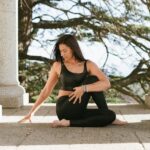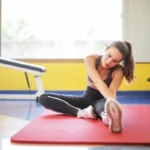Looking for a safe and effective way to stay active in your golden years? The right full-body workout can make all the difference in maintaining your strength, balance, and independence. Our expert-designed 20-minute workout routine is specifically crafted for seniors who want to enhance their fitness without overexertion. Whether you’re new to exercise or looking to modify your current routine, we’ve got you covered. In this comprehensive guide, you’ll discover: • Simple yet effective exercises targeting all major muscle groups • Safe modifications for different fitness levels and mobility needs • Expert tips for proper form and injury prevention • A time-efficient routine that fits easily into your daily schedule Ready to boost your strength and energy with a workout that’s both gentle and effective? Let’s explore this senior-friendly fitness routine that can help you maintain an active, independent lifestyle.
Key Takeaways:
- – The 20-minute routine combines strength training and functional movements, designed specifically for older adults with different mobility levels.
- – All exercises can be modified using household items like water bottles or resistance bands, eliminating the need for expensive fitness center memberships or additional costs.
- – The workout targets multiple muscle groups through total body exercises, helping maintain muscle mass and functional stability while improving daily activities.
- – Safety is paramount – the routine includes proper warm-up moves, maintains a steady pace, and offers plenty of breaks to ensure better recovery.
- – The beginner-intermediate level routine can be adjusted based on individual health conditions and mobility limitations, with guidance on maintaining good form throughout.
Benefits of Regular Exercise for Seniors
Regular physical activity plays a vital role in maintaining health and independence as we age. Understanding these benefits can motivate seniors to embrace an active lifestyle and improve their overall quality of life.
Enhanced Physical Health
Regular exercise helps seniors maintain muscle mass and bone density, reducing the risk of falls and fractures. It also improves cardiovascular health, lowers blood pressure, and helps manage chronic conditions like diabetes and arthritis.
Better Mental Well-being
Physical activity stimulates the release of endorphins, natural mood boosters that help combat depression and anxiety. Exercise also promotes better sleep patterns and reduces stress levels, contributing to improved cognitive function and mental clarity.
Increased Independence
Staying active helps seniors maintain the strength and mobility needed for daily activities. From carrying groceries to climbing stairs, regular exercise ensures the ability to perform everyday tasks without assistance, fostering a sense of independence and confidence.
Social Connection
Group exercise classes or walking clubs provide excellent opportunities for seniors to socialize and build meaningful relationships. These social connections are crucial for emotional well-being and can help prevent feelings of isolation common among older adults.
Disease Prevention
Regular physical activity strengthens the immune system and helps prevent various age-related conditions. Studies show that active seniors have a lower risk of developing heart disease, certain cancers, and cognitive disorders like dementia.
Improved Balance and Coordination
Exercise enhances proprioception – the body’s ability to sense its position in space. This improvement leads to better balance and coordination, significantly reducing the risk of falls, which can be particularly dangerous for older adults.
💡 Key Takeaway: Regular exercise offers seniors multiple benefits, from enhanced physical and mental health to increased independence and social connections, making it an essential component of healthy aging.
Essential Safety Guidelines Before Starting
Before diving into any exercise routine, it’s crucial to prioritize your safety and well-being. Let’s explore the essential precautions you need to take to ensure a safe and effective workout experience.
Consult Your Healthcare Provider
Always get clearance from your doctor before starting any new exercise program. This is particularly important if you have pre-existing conditions, recent surgeries, or chronic health issues. Your healthcare provider can offer personalized recommendations based on your medical history.
Check Your Environment
Create a safe workout space by removing potential hazards like loose rugs or electrical cords. Ensure proper lighting and ventilation. Keep a sturdy chair nearby for balance support during standing exercises. Having a non-slip exercise mat can provide extra stability and comfort.
Listen to Your Body
Pay attention to how you feel during exercise. Stop immediately if you experience chest pain, severe shortness of breath, dizziness, or sharp joint pain. It’s normal to feel some muscle fatigue, but pain is your body’s way of signaling that something isn’t right.
Start Gradually
Begin with gentle movements and lighter intensities. Don’t rush into complex exercises or heavy weights. Focus on mastering proper form before increasing difficulty. Remember, progress takes time, and starting slowly helps prevent injuries.
Stay Hydrated
Keep water nearby and drink before, during, and after your workout. Proper hydration helps maintain energy levels and prevents dizziness. If you’re exercising in a warm environment, increase your fluid intake accordingly.
💡 Key Takeaway: Prioritize safety by consulting healthcare providers, creating a safe environment, listening to your body’s signals, starting gradually, and maintaining proper hydration throughout your workout routine.
Required Equipment and Space
Starting a workout routine doesn’t require an elaborate home gym setup. You can achieve an effective full-body workout with just a few basic items.
Essential Equipment
– A sturdy chair with armrests for balance and support
– Resistance bands (light to medium resistance)
– Light dumbbells (2-5 pounds) or filled water bottles
– Non-slip exercise mat
– Comfortable, supportive athletic shoes
Space Requirements
Creating a safe workout environment is crucial. Clear a space roughly 6×6 feet to allow for comfortable movement. Ensure the area is:
– Well-ventilated
– Free from obstacles and tripping hazards
– Located near a wall for additional support if needed
– Has adequate lighting
– Features a non-slip surface
Safety Considerations
Keep all equipment within easy reach during your workout. Place your chair on a flat, stable surface away from rugs or uneven flooring. Store resistance bands and weights properly to prevent accidents.
💡 Key Takeaway: A basic home workout setup requires minimal equipment and a small, clear space with proper safety measures in place – making it accessible for seniors to start their fitness journey.
5-Minute Warm-Up Routine
A proper warm-up is essential before diving into any workout routine, especially for seniors. It helps prepare your body for exercise by increasing blood flow to your muscles and improving flexibility.
Marching in Place (1 minute)
Start with a gentle march in place. Lift your knees to a comfortable height while swinging your arms naturally. This simple movement increases your heart rate gradually and warms up your leg muscles.
Shoulder Rolls (1 minute)
Roll your shoulders forward 5 times, then backward 5 times. This helps loosen up your upper body and reduces stiffness in your neck and shoulder area. Keep the movements slow and controlled.
Arm Circles (1 minute)
Make small circles with your arms extended to the sides. Start with forward circles for 30 seconds, then switch to backward circles. This exercise warms up your shoulder joints and upper back muscles.
Ankle and Wrist Rotations (1 minute)
While seated, rotate each ankle clockwise and counterclockwise 5 times. Then rotate your wrists in both directions. These movements improve joint mobility and prevent stiffness.
Light Walking (1 minute)
Walk in place or around the room at a comfortable pace. Focus on taking deep breaths and maintaining good posture. This final warm-up exercise gets your whole body moving and ready for the main workout.
💡 Key Takeaway: A 5-minute warm-up routine incorporating gentle movements like marching, shoulder rolls, and joint rotations prepares your body safely for exercise while reducing the risk of injury.
10-Minute Strength Training Circuit
Circuit Overview
Start your strength training journey with this efficient 10-minute circuit designed specifically for seniors. This carefully structured workout targets major muscle groups while maintaining safety and proper form. Begin with 30 seconds of each exercise, followed by a 15-second rest period.
Exercise Sequence
1. Chair-Assisted Squats
– Stand behind a sturdy chair, holding the back for support
– Lower your body as if sitting down, keeping knees aligned with toes
– Push through your heels to return to standing
– Perform for 30 seconds
2. Modified Push-Ups
– Place hands on a wall at chest height
– Keep your body straight and core engaged
– Lower chest toward wall and push back
– Continue for 30 seconds
3. Seated Arm Circles
– Sit tall in a chair with arms extended
– Make small circular motions forward, then backward
– Keep shoulders relaxed and maintain good posture
– Complete 30 seconds total
4. Standing Knee Lifts
– Hold chair back for balance
– Alternate lifting knees toward chest
– Focus on controlled movements
– Continue for 30 seconds
5. Seated Core Rotations
– Sit straight with feet flat
– Hold arms at chest level
– Rotate torso gently side to side
– Maintain for 30 seconds
Remember to breathe steadily throughout each exercise. If you feel any discomfort, take additional rest periods or modify the movements to suit your comfort level. Complete this circuit twice for optimal benefits.
💡 Key Takeaway: This 10-minute strength circuit combines five essential exercises targeting major muscle groups, offering a time-efficient workout that builds functional strength while prioritizing safety and proper form.
5-Minute Balance and Core Work
Balance and core exercises form a crucial component of any senior fitness routine, helping to prevent falls and maintain stability in daily activities. Let’s explore some effective exercises that you can perform safely in just 5 minutes.
Standing Hip Abductions
Stand behind a sturdy chair, holding it for support. Slowly lift your right leg out to the side while keeping it straight. Hold for 2-3 seconds, then lower it back down. Repeat with the left leg. Perform 8-10 repetitions on each side.
Modified Planks
Place your forearms on a chair seat or against a wall. Keep your body in a straight line from head to heels. Hold this position for 15-30 seconds, focusing on engaging your core muscles. Remember to breathe steadily throughout the exercise.
Seated Core Rotations
Sit tall in a chair with feet flat on the floor. Hold your arms at chest height, elbows bent. Slowly rotate your upper body to the right, then return to center. Rotate to the left and return to center. Complete 10 rotations on each side.
Single-Leg Stance
Stand near a wall or chair for support if needed. Lift one foot slightly off the ground and try to maintain balance for 10-15 seconds. Switch legs and repeat. As you improve, try to reduce your reliance on support.
Bird Dog Hold
Start on hands and knees on a mat. Extend your right arm forward while simultaneously extending your left leg backward. Hold for 5 seconds while maintaining balance. Return to starting position and alternate sides. Perform 6-8 repetitions per side.
💡 Key Takeaway: This 5-minute balance and core routine combines essential exercises to enhance stability, strengthen your core, and improve overall balance, helping you maintain independence in daily activities.
Exercise Modifications and Alternatives
Exercise modifications are essential for seniors to maintain safety and comfort during their workout routine. Each exercise can be adapted to match individual fitness levels and physical limitations.
Chair-Based Modifications
For those with balance concerns or mobility issues, many exercises can be performed while seated. Standing exercises like squats can be modified to chair sits, where you slowly lower yourself to barely touch the chair before rising back up. This provides stability while still engaging the leg muscles effectively.
Low-Impact Alternatives
High-impact movements can be replaced with gentler options. Instead of jumping jacks, try step-out jacks where you step side to side while raising your arms. For marching in place, lift your knees only as high as comfortable, focusing on controlled movements rather than speed.
Using Support Tools
Incorporating support tools can make exercises more manageable. A sturdy chair or wall can provide balance during standing exercises. Resistance bands offer a safer alternative to free weights, allowing for controlled movements with adjustable resistance levels.
Simplified Movements
Complex exercises can be broken down into simpler components. Rather than performing a full push-up, try wall push-ups or incline push-ups against a counter. This maintains the core strengthening benefits while reducing strain on joints and muscles.
💡 Key Takeaway: Exercise modifications ensure seniors can safely participate in workouts by adapting movements to their abilities, using support tools, and simplifying complex exercises for optimal results.
Weekly Workout Schedule and Progression
Starting a new workout routine requires careful planning and progression. Let’s break down how to structure your weekly workouts effectively while ensuring adequate rest and recovery.
Recommended Weekly Schedule
Begin with 2-3 sessions per week, spacing them out evenly. For example, try exercising on Monday, Wednesday, and Friday. This allows for proper recovery between workouts, which is crucial for seniors to prevent overexertion and maintain energy levels.
Rest and Recovery Days
On non-workout days, engage in light activities like walking or gentle stretching. These active recovery days help maintain mobility while giving your muscles time to repair and strengthen. Listen to your body – if you feel unusually tired or sore, take an extra rest day.
Progressive Overload
As your strength and endurance improve, gradually increase the challenge. Start with 1 set of each exercise, then progress to 2-3 sets after a few weeks. You can also increase repetitions from 8 to 12, or add light weights when bodyweight exercises become too easy.
Monthly Progress Check
At the end of each month, assess your progress. Can you perform exercises with better form? Are daily activities becoming easier? Use these observations to adjust your workout intensity. If exercises feel too easy, consider advancing to more challenging variations.
Signs of Good Progress
– Improved balance during exercises
– Better endurance in daily activities
– Increased range of motion
– Enhanced strength in functional movements
– More confidence in movement patterns
💡 Key Takeaway: Start with 2-3 weekly sessions, prioritize rest days, and gradually increase intensity as you build strength and confidence, always listening to your body’s signals for optimal progression.
Conclusion
Embarking on a fitness journey in your senior years is a powerful step toward maintaining independence and vitality. This 20-minute full-body workout routine offers a practical, adaptable approach to strength training that can easily fit into your daily schedule, helping you build functional stability and maintain muscle mass without overwhelming your body. Remember, consistency is key to achieving lasting results. Start with modifications that match your current fitness level, and gradually increase the level of challenge as you grow stronger. Always listen to your body and consult your healthcare provider before beginning any new exercise routine, especially if you have chronic conditions. By dedicating just 20 minutes a day to this workout, you’re investing in a healthier body and better quality of life. Whether you’re using resistance bands, water bottles as weights, or simply your body weight, each exercise brings you closer to your fitness goals. Start today, and experience the transformative benefits of regular exercise in your golden years.
FAQs
Can seniors with arthritis participate in this 20-minute full-body workout?
Yes, seniors with arthritis can participate by following the modifications provided. Start slowly, focus on gentle movements, and avoid exercises that cause discomfort. Always consult your healthcare provider before starting, and adjust the intensity based on your comfort level.
How often should seniors perform this full-body workout routine?
For optimal results, seniors should aim to perform this total body workout 2-3 times per week with a day of rest between sessions. This allows for better recovery and helps maintain functional stability while preventing overexertion.
What are the signs that indicate I should stop exercising?
Stop exercising immediately if you experience chest pain, severe shortness of breath, dizziness, or much pain in your joints. Take plenty of breaks when needed, and maintain a steady pace throughout the workout. Contact your healthcare provider if symptoms persist.
Do I need special equipment for this workout routine?
No, this workout requires minimal equipment. You can use household items like water bottles as handheld weights, or resistance bands if available. The exercises are designed to be performed in an open space with basic items you already have at home.
Will this workout help improve balance and reduce fall risk?
Yes, this workout includes exercises that enhance functional stability and strengthen muscle groups essential for balance. Regular exercise using this routine can help improve coordination, strengthen your core, and reduce the risk of falls in older adults.
Can this workout be modified for seniors who can’t stand for long periods?
Absolutely! Many exercises in this routine can be modified to be performed while seated, making it accessible for those with limited mobility or balance issues. Focus on upper body endurance and seated movements while maintaining good form.
![The Ultimate 20-Minute Full-Body Workout Guide for Seniors [With Modifications]](https://bodyamigo.com/wp-content/uploads/2025/01/pexels-photo-3822220.jpeg)




![The Ultimate Guide to Increasing Flexibility: 10 Simple At-Home Exercises [With Videos]](https://bodyamigo.com/wp-content/uploads/2025/01/pexels-photo-3757955-440x293.webp)
![The Ultimate Guide to Increasing Flexibility: 10 Simple At-Home Exercises [With Videos]](https://bodyamigo.com/wp-content/uploads/2025/01/pexels-photo-3757955-320x213.webp)


Leave a Comment